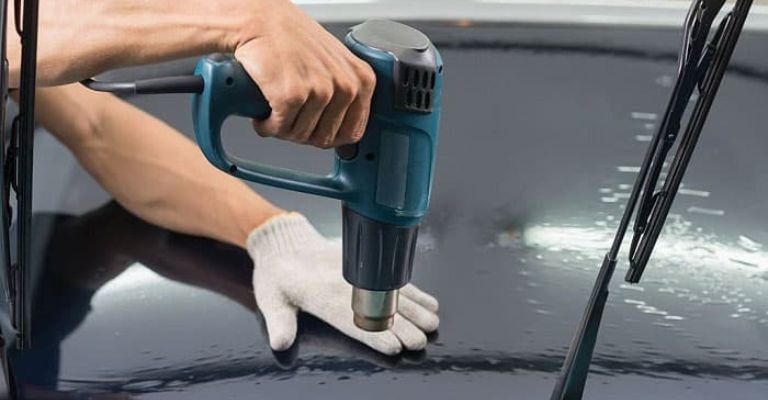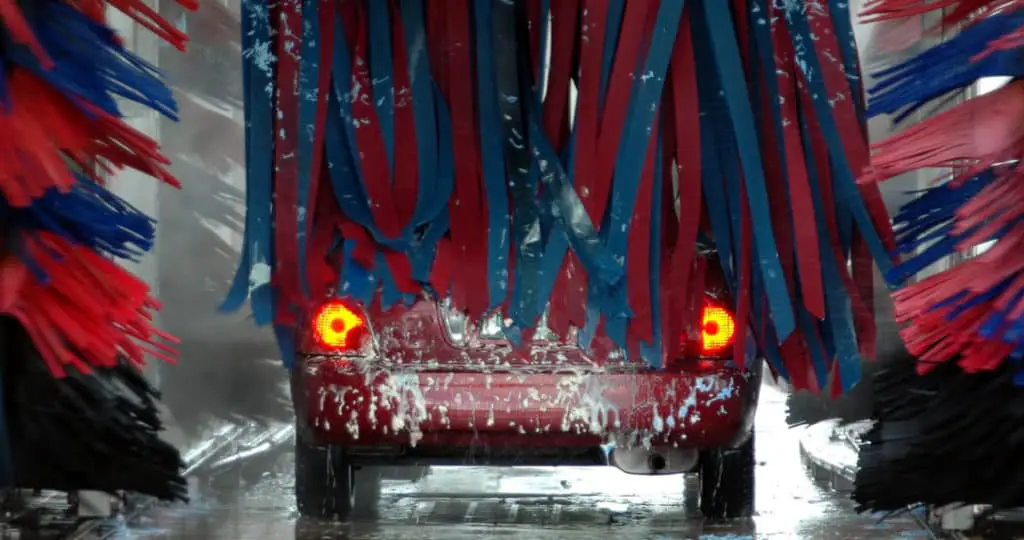- How to Clean Car Carpets Quickly (Without An Extractor) - July 10, 2024
- Can You Touch Up Clear Coat On A Car? Yes and No (Here’s Why) - November 25, 2023
- How To Wax A Car By Hand (For Beginners) - November 14, 2023
Last Updated on December 10, 2024 by Nate Schnell
Faded plastic trim on your car is a common issue, especially if the vehicle spends a lot of time outdoors exposed to UV rays and harsh weather. Over time, this exposure bleaches the plastic, leaving it dull and gray. If you’ve been researching solutions, you may have come across a method that involves using a heat gun to restore the plastic’s original color. But does it really work? The answer is yes, but it comes with some caveats.
Using a heat gun to restore plastic can be effective, but it’s not without risks. The method works by applying heat to break down and realign the molecular structure of the plastic, effectively rejuvenating its color and surface. While this sounds promising, improper use can lead to melted or damaged plastic. To help you make an informed decision, let’s break down how this process works, its pros and cons, and alternative options you might consider.
How Does Heat Gun Plastic Restoration Work?
When you use a heat gun on faded plastic, the heat causes the polymers in the plastic to soften slightly, which realigns their structure and brings the original pigments to the surface. This process often results in a rich, glossy appearance that makes the plastic look nearly new. However, achieving this outcome requires careful application and a good understanding of the material you’re working with.
The key to success is maintaining control over the heat. Excessive heat can cause the plastic to warp, melt, or become brittle, while insufficient heat won’t produce the desired effect. The process also requires patience and precision, as rushing through it can result in uneven results or permanent damage to the plastic.
Preparing for Heat Gun Plastic Restoration
Preparation is critical to ensuring a successful restoration. Here are some steps to get started:
- Clean the Plastic: Begin by thoroughly cleaning the plastic surface with soap and water. Remove all dirt, grease, and residue, as these can interfere with the heat treatment.
- Inspect the Surface: Check for cracks, chips, or areas where the plastic is already compromised. Heat can worsen these issues, so it’s best to avoid applying the heat gun to damaged areas.
- Choose the Right Heat Gun: Not all heat guns are the same. Look for one with adjustable heat settings so you can fine-tune the temperature to suit the plastic’s needs.
- Wear Protective Gear: Safety is important. Wear heat-resistant gloves and work in a well-ventilated area to avoid inhaling any fumes released during the process.
Step-by-Step Guide to Using a Heat Gun on Plastic
Follow these steps to restore faded plastic with a heat gun:
- Set Up Your Heat Gun: Plug in the heat gun and select a medium heat setting. Let it warm up for a few minutes.
- Maintain Proper Distance: Hold the heat gun 4–6 inches away from the plastic surface. This prevents overheating and melting.
- Apply Heat Evenly: Move the heat gun in a slow, circular motion across the surface. Avoid staying in one spot for too long, as this can cause discoloration or damage.
- Watch for Changes: As you apply heat, you’ll notice the color of the plastic starting to deepen. Stop heating once you achieve the desired result.
- Cool Down: Allow the plastic to cool completely before touching or applying any products.
- Optional: Apply a Plastic Restorer: For additional protection and shine, consider applying a plastic restorer after the plastic has cooled. This step helps seal the surface and protect it from future fading.
Benefits of Using a Heat Gun
- Quick Results: Heat gun restoration can deliver visible improvements in minutes, making it an efficient option for faded trim.
- Cost-Effective: If you already own a heat gun, this method is inexpensive compared to buying professional-grade restorers or replacement parts.
- Reusable Tool: A heat gun can be used for various other purposes, making it a versatile addition to your toolkit.
Risks and Precautions
While the heat gun method can be effective, it comes with risks that should not be overlooked. Improper use can result in:
- Melted Plastic: Excessive heat can warp or permanently damage the plastic, making it unsalvageable.
- Brittleness: Overheating can make plastic more prone to cracking over time.
- Uneven Results: Rushed application can lead to patchy or inconsistent restoration.
- Safety Hazards: Heat guns generate high temperatures, so always wear gloves and keep flammable materials away from your workspace.
To minimize risks, always test the heat gun on a small, inconspicuous area first. This allows you to gauge how the plastic reacts and make adjustments before tackling the entire surface.
Alternatives to Using a Heat Gun
If you’re hesitant to use a heat gun or your plastic trim is severely damaged, consider these alternatives:
- Plastic Restorers: Products like Meguiar’s Ultimate Black or Solution Finish are specifically designed to restore plastic surfaces. These are easy to apply and provide long-lasting results.
- Chemical Dressings: Some detailing products contain UV inhibitors that can help restore and protect faded plastic.
- Painting: For heavily damaged or deeply faded plastic, painting may be the most durable solution. Use a plastic primer and paint designed for automotive trim to achieve professional results.
Finishing Touches and Aftercare
To prolong the results of your heat gun restoration, use a high-quality plastic restorer or UV protectant. These products add an extra layer of protection against sunlight, rain, and dirt, keeping your trim looking great for longer. Regular cleaning and reapplication of protectants can help maintain the restored look.
Popular aftercare products include Meguiar’s Ultimate Black Plastic Restorer and 303 Aerospace Protectant. Both are easy to use and provide excellent UV protection.
Is a Heat Gun Right for You?
Using a heat gun to restore plastic is an excellent option if you’re confident in your ability to control the heat and follow the process carefully. It’s a fast and cost-effective way to rejuvenate faded trim, but it requires precision and patience. If you’re unsure about your skills or the condition of the plastic, alternatives like restorers or painting might be safer choices.
FAQs
Is it safe to use a heat gun on plastic?
Yes, as long as you follow the proper precautions. Always keep the heat gun moving, maintain a safe distance, and avoid overheating the surface.
How long do the results of heat gun restoration last?
The results can last several months to a year, depending on exposure to sunlight and weather. Using a plastic restorer or protectant can extend the lifespan of the restoration.
Can I use a hairdryer instead of a heat gun?
No, a hairdryer doesn’t generate enough heat to effectively restore plastic. A heat gun is necessary for this process.
What should I do if I accidentally melt the plastic?
If the plastic melts, there’s little you can do to reverse the damage. You may need to replace the part or consider sanding and repainting it.
Restoring faded plastic with a heat gun can be a rewarding project when done correctly. By following the steps and precautions outlined here, you can achieve impressive results and bring your car’s trim back to life.



